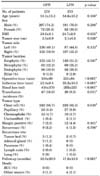1. Belldegrun A, Tsui KH, deKernion JB, Smith RB. Efficacy of nephron-sparing surgery for renal cell carcinoma: analysis based on the new 1997 tumor-node-metastasis staging system. J Clin Oncol. 1999. 17:2868–2875.
2. Uzzo RG, Novick AC. Nephron sparing surgery for renal tumors: indications, techniques and outcomes. J Urol. 2001. 166:6–18.
3. Fergany AF, Hafez KS, Novick AC. Long-term results of nephron sparing surgery for localized renal cell carcinoma: 10-year followup. J Urol. 2000. 163:442–445.
4. Marszalek M, Ponholzer A, Brossner C, Wachter J, Maier U, Madersbacher S. Elective open nephron-sparing surgery for renal masses: single-center experience with 129 consecutive patients. Urology. 2004. 64:38–42.
5. Lerner SE, Hawkins CA, Blute ML, Grabner A, Wollan PC, Eickholt JT, et al. Disease outcome in patients with low stage renal cell carcinoma treated with nephron sparing or radical surgery. J Urol. 1996. 155:1868–1873.
6. Gill IS, Desai MM, Kaouk JH, Meraney AM, Murphy DP, Sung GT, et al. Laparoscopic partial nephrectomy for renal tumor: duplicating open surgical techniques. J Urol. 2002. 167:469–467.
7. Orvieto MA, Chien GW, Laven B, Rapp DE, Sokoloff MH, Shalhav AL. Eliminating knot tying during warm ischemia time for laparoscopic partial nephrectomy. J Urol. 2004. 172:2292–2295.
8. Thompson T, Ng CF, Tolley D. Renal parenchymal hemostatic aids: glues and things. Curr Opin Urol. 2003. 13:209–214.
9. Richter F, Schnorr D, Deger S, Trk I, Roigas J, Wille A, et al. Improvement of hemostasis in open and laparoscopically performed partial nephrectomy using a gelatin matrix-thrombin tissue sealant (FloSeal). Urology. 2003. 61:73–77.
10. Chien GW, Orvieto MA, Chuang MS, Sokoloff MH, Gerber GS, Shalhav AL. Use of suspension traction system for renal positioning during laparoscopic partial nephrectomy. J Endourol. 2005. 19:406–409.
11. Sundaram CP, Rehman J, Venkatesh R, Lee D, Rageb MM, Kibel A, et al. Hemostatic laparoscopic partial nephrectomy assisted by a water-cooled, high-density, monopolar device without renal vascular control. Urology. 2003. 61:906–909.
12. Marszalek M, Meixl H, Polajnar M, Rauchenwald M, Jeschke K, Madersbacher S. Laparoscopic and open partial nephrectomy: a matched-pair comparison of 200 patients. Eur Urol. 2009. 55:1171–1178.
13. Herr HW. Partial nephrectomy for unilateral renal carcinoma and a normal contralateral kidney: 10-year followup. J Urol. 1999. 161:33–34.
14. Stevens LA, Levey AS. Measured GFR as a confirmatory test for estimated GFR. J Am Soc Nephrol. 2009. 20:2305–2313.
15. Levey AS, Coresh J, Balk E, Kausz AT, Levin A, Steffes MW, et al. National Kidney Foundation practice guidelines for chronic kidney disease: evaluation, classification, and stratification. Ann Intern Med. 2003. 139:137–147.
16. Simmons MN, Gill IS. Decreased complications of contemporary laparoscopic partial nephrectomy: use of a standardized reporting system. J Urol. 2007. 177:2067–2073.
17. Schiff JD, Palese M, Vaughan ED Jr, Sosa RE, Coll D, Del Pizzo JJ. Laparoscopic vs open partial nephrectomy in consecutive patients: the Cornell experience. BJU Int. 2005. 96:811–814.
18. Patard JJ, Shvarts O, Lam JS, Pantuck AJ, Kim HL, Ficarra V, et al. Safety and efficacy of partial nephrectomy for all T1 tumors based on an international multicenter experience. J Urol. 2004. 171:2181–2185.
19. Gill IS, Kavoussi LR, Lane BR, Blute ML, Babineau D, Colombo JR Jr, et al. Comparison of 1,800 laparoscopic and open partial nephrectomies for single renal tumors. J Urol. 2007. 178:41–46.
20. Porpiglia F, Volpe A, Billia M, Renard J, Scarpa RM. Assessment of risk factors for complications of laparoscopic partial nephrectomy. Eur Urol. 2008. 53:590–596.
21. Porpiglia F, Volpe A, Billia M, Scarpa RM. Laparoscopic versus open partial nephrectomy: analysis of the current literature. Eur Urol. 2008. 53:732–742.
22. Gong EM, Orvieto MA, Zorn KC, Lucioni A, Steinberg GD, Shalhav AL. Comparison of laparoscopic and open partial nephrectomy in clinical T1a renal tumors. J Endourol. 2008. 22:953–957.
23. Lane BR, Gill IS. 5-year outcomes of laparoscopic partial nephrectomy. J Urol. 2007. 177:70–74.
24. Canes D. Long-term oncological outcomes of laparoscopic partial nephrectomy. Curr Opin Urol. 2008. 18:145–149.
25. Lane BR, Novick AC, Babineau D, Fergany AF, Kaouk JH, Gill IS. Comparison of laparoscopic and open partial nephrectomy for tumor in a solitary kidney. J Urol. 2008. 179:847–851.
26. Kwon EO, Carver BS, Snyder ME, Russo P. Impact of positive surgical margins in patients undergoing partial nephrectomy for renal cortical tumours. BJU Int. 2007. 99:286–289.






 PDF
PDF ePub
ePub Citation
Citation Print
Print





 XML Download
XML Download